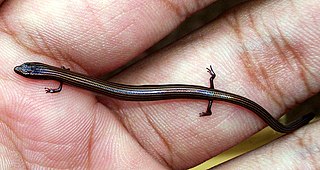
Skinks are lizards belonging to the family Scincidae, a family in the infraorder Scincomorpha. With more than 1,500 described species across 100 different taxonomic genera, the family Scincidae is one of the most diverse families of lizards. Skinks are characterized by their smaller legs in comparison to typical lizards and are found in different habitats except arctic and subarctic regions.

Ablepharus is a genus of skinks that contains the common snake-eyed skinks. Both their scientific and common names refer to the fact that their eyelids have fused to a translucent capsule; as in snakes, they thus are physically incapable of blinking. They are small lizards and prefer to live in the leaf litter of dry fields and hills. Their scales give them a very shiny, bronze appearance with a characteristically dark stripe down the sides of their bodies. They prey on small insects and other small mollusks.
Nessia is a genus of skinks, lizards in the family Scincidae. The genus is endemic to Sri Lanka. Species in the genus Nessia are commonly known as snake skinks.
Notoscincus is a genus of skinks. They are commonly known as soil-crevice skinks or snake-eyed skinks.

Plestiodon gilberti, commonly known as Gilbert's skink, is a species of heavy-bodied medium-sized lizard in the family Scincidae. The species is endemic to the southwestern United States, and grows to about 7 to 12 cm in total length.

Friedrich "Fritz" Müller was a Swiss doctor, zoologist, and herpetologist.

Riopa lineata, the lined writhing skink or lined supple skink, is a species of writhing skink. It is known from India, Bangladesh and Myanmar. This skink grows to about 6 cm in length. The body colouration is golden and each scale has a black dot forming longitudinal stripes on the body. It is known to occur from Gujarat to north of Karnataka. In Mumbai this skink has been observed in the Sanjay Gandhi National Park and Aarey milk colony. It is often found under rocks, loose soil associated with termite mounds and ant hills. It is crepuscular. A captive individual accepted termites, mosquito, house flies, ant eggs for about 45 days and was released.

Scincinae is a subfamily of lizards. The subfamily contains 33 genera, and the genera contain a combined total of 284 species, commonly called skinks. The systematics is at times controversial. The group is probably paraphyletic. It is one of three subfamilies of the family Scincidae, the other two being Acontinae and Lygosominae.
Lycodon carianatus is a snake of the Colubridae family. It is endemic to the island of Sri Lanka. The snake is commonly known as the Sri Lankan Wolf Snake, and as දාර කරවලා or දාර රදනකයා in Sinhala.
Thwaites's skink, also known commonly as the fourtoe snakeskink, is a species of skink, a lizard in the family Scincidae. The species is endemic to the island of Sri Lanka.

Lankascincus fallax, also known commonly as the common supple skink and Peters's tree skink, is a species of lizard in the family Scincidae. The species is endemic to the island of Sri Lanka.
Smith's snake skink, also known as the two-legged nessia, is a species of skink endemic to island of Sri Lanka.
Nessia burtonii, commonly known as Burton's nessia, Gray's snake skink, or the three-toed snake skink, is a species of skink, a lizard in the family Scincidae. The species is endemic to the island of Sri Lanka.
Nessia deraniyagalai, commonly known as Deraniyagala's snake skink, Deraniyagala's snakeskink, or Deraniyagala's nessia, is a species of limbless lizard in the family Scincidae. The species is endemic to the island of Sri Lanka.
Nessia didactyla, also known as the two-toed nessia and two-toed snakeskink, is a species of skink endemic to island of Sri Lanka.
Nessia hickanala, also known as the shark-headed snake skink and Hickanala nessia, is a species of skink endemic to island of Sri Lanka.
Nessia layardi, commonly known as Layard's snake skink or Layard's nessia, is a species of skink, a lizard in the family Scincidae. The species is endemic to the island of Sri Lanka.
Nessia sarasinorum, commonly known as Sarasins's snake skink or Müller's nessia, is a species of lizard in the family Scincidae. The species is endemic to the island of Sri Lanka.
Nessia gansi, also known commonly as Gans's three-toed snake skink, is a species of lizard in the family Scincidae. The species is endemic to the island of Sri Lanka.






